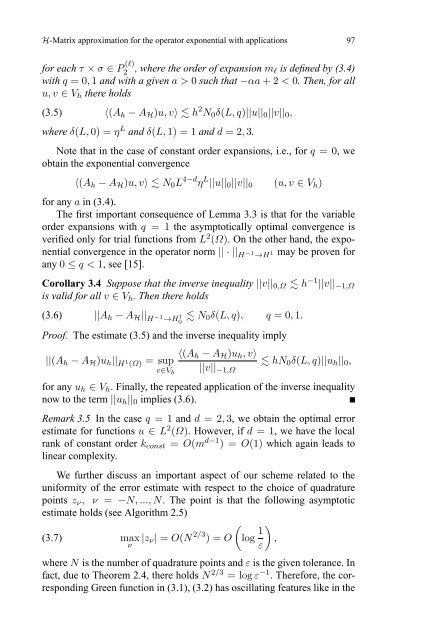H-Matrix approximation for the operator exponential with applications
H-Matrix approximation for the operator exponential with applications
H-Matrix approximation for the operator exponential with applications
You also want an ePaper? Increase the reach of your titles
YUMPU automatically turns print PDFs into web optimized ePapers that Google loves.
H-<strong>Matrix</strong> <strong>approximation</strong> <strong>for</strong> <strong>the</strong> <strong>operator</strong> <strong>exponential</strong> <strong>with</strong> <strong>applications</strong> 97<br />
<strong>for</strong> each τ × σ ∈ P (l)<br />
2 , where <strong>the</strong> order of expansion m l is defined by (3.4)<br />
<strong>with</strong> q =0, 1 and <strong>with</strong> a given a>0 such that −αa +2< 0. Then, <strong>for</strong> all<br />
u, v ∈ V h <strong>the</strong>re holds<br />
(3.5) 〈(A h − A H )u, v〉 h 2 N 0 δ(L, q)||u|| 0 ||v|| 0 ,<br />
where δ(L, 0) = η L and δ(L, 1)=1and d =2, 3.<br />
Note that in <strong>the</strong> case of constant order expansions, i.e., <strong>for</strong> q =0,we<br />
obtain <strong>the</strong> <strong>exponential</strong> convergence<br />
〈(A h − A H )u, v〉 N 0 L 4−d η L ||u|| 0 ||v|| 0 (u, v ∈ V h )<br />
<strong>for</strong> any a in (3.4).<br />
The first important consequence of Lemma 3.3 is that <strong>for</strong> <strong>the</strong> variable<br />
order expansions <strong>with</strong> q =1<strong>the</strong> asymptotically optimal convergence is<br />
verified only <strong>for</strong> trial functions from L 2 (Ω). On <strong>the</strong> o<strong>the</strong>r hand, <strong>the</strong> <strong>exponential</strong><br />
convergence in <strong>the</strong> <strong>operator</strong> norm ||·|| H −1 →H1 may be proven <strong>for</strong><br />
any 0 ≤ q
















